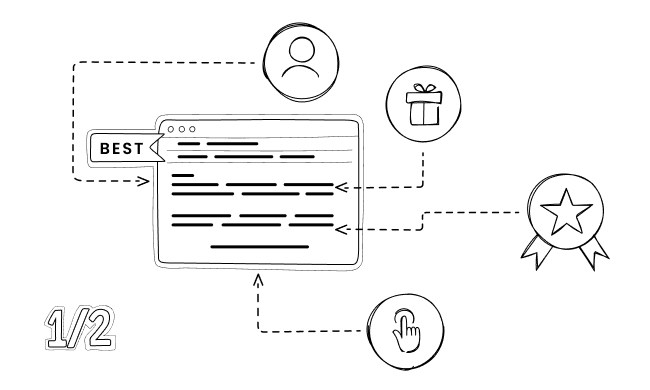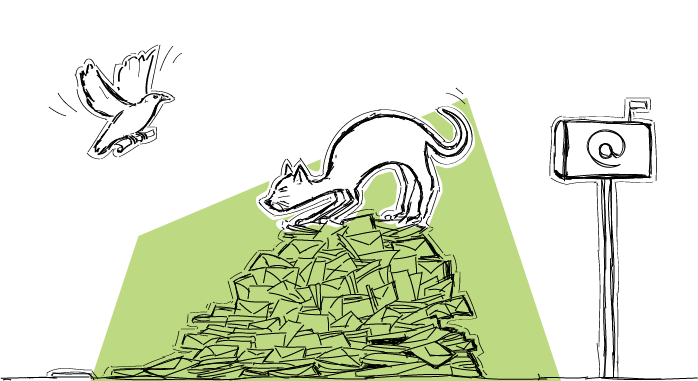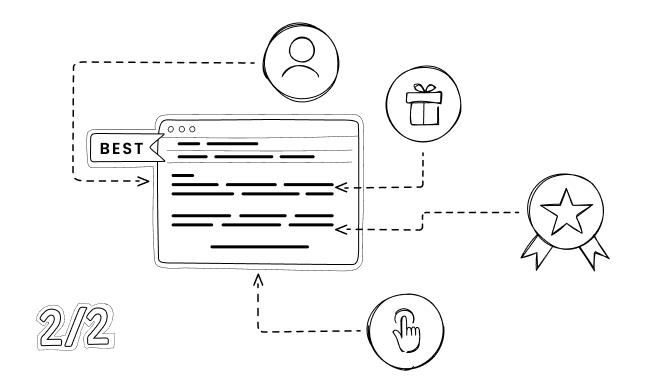This is part two of the blog post you’ve been waiting for… trust me.
I asked four people from the Woodpecker team about the best cold email they ever got, and ran an in-depth analysis of their subject lines, email body and CTA.
You’ll learn how to craft a top-tier cold email that your prospects just won’t be able to resist.
In part two, I’m diving deep into Cathy’s (our CMO) and Matt’s (our CEO) fave cold emails that they ever got. (For part one, go here.)
Example #3: the best cold email Cathy ever got
Hey Cathy, I’m trying to figure out some outreach tricks that remain behind the scenes and wanted to pick up on your point about personalization (from this post): Remember that influencers usually get tons of emails. To catch their eye, you need something more than: “I’m reading your blog. Great stuff.” Refer to a chosen part of the article. It makes pretty good sense, but there’s one thing that got me a bit puzzled. Do you mind if I send you a question? I’m also writing an article for our blog and could quote you there (with attribution to Woodpecker.co). Let me know if you’d be interested Cheers, Nick Campbell
What Cathy thought about the email:
“After this exchange, I invited Nick to write us a guest blog post about his approach to follow-ups – as I liked his follow-up so much. So not only did he get what he asked for in the first place, but more – because of course in the guest post he got a free link to himself.”
Let’s analyze:
- ‘Subject line: About your cold outreach tip’
The subject line used in this cold email example is highly relevant and intriguing. It’s fairly short but manages to prompt an “Ooh, I wonder which outreach tip they’re on about” moment.
Although Cathy gets plenty of emails every single day, in this case the subject line got her so hooked, and she was so curious to find out which tip Nick was referring to, that she opened the email. This is crucial because the subject line is the key to your entire message, which is locked until the prospect decides to open it.
So remember, if your prospect doesn’t find your subject line personally relevant, interesting or valuable, they simply won’t open the email.
Another great thing about this subject line is that it’s closely tied to the email copy, which is extremely important. It helps the reader follow on smoothly from the subject line to the rest of the message and not lose focus.
That’s why you should stay away from clickbait-style subject lines, whose sole purpose is to get the prospect to open the message. Once the prospect discovers the subject line has absolutely nothing to do with the rest of the message they’ll just get annoyed – which means you can forget about getting a reply.
- ‘I’m trying to figure out some outreach tricks that remain behind the scenes and wanted to pick up on your point about personalization (from this post):’
The subject line links seamlessly to the first sentence of the message.
Straight away, Nick makes the reason for reaching out clear and adds a professionally-looking hyperlink to a specific blog post, which increases the credibility of his message.
Adding links to your cold emails (especially too many links) might influence your deliverability, so think twice before doing so. But if you really want to, use custom tracking domains, and add your link just like Nick did in his email.
Usually, links in cold emails are considered “suspicious” and very few people click on them. But in this cold email example, Nick wrote the message in such a way that I’d probably have clicked on it myself. Also, the link goes to Cathy’s article, and not Nick’s company site.
Including a link to the exact blog post highlights to the prospect that you respect their time. It also boosts the chances of your prospect actually clicking on it, as it’s easy for them: the link is already there, it looks professional and they don’t have to spend their time looking for it.
And don’t ever expect your prospect to manually search for an article you’re asking about, ’cause – spoiler alert – they won’t.
So if you’re adding a link, make sure it’s a neatly-looking hyperlink in your text, like it was done in this cold email example, and avoid including the bare URL as it looks 1. messy and 2. very unprofessional (or even suspicious).
Nick then quotes the exact part of the blog post he is referring to:
- ‘Remember that influencers usually get tons of emails. To catch their eye, you need something more than: “I’m reading your blog. Great stuff.” Refer to a chosen part of the article.’
Keep in mind that you’re trying to do everything to make the prospect’s job – aka replying – as easy for them as possible.
Quoting the specific part of the article in your email helps the reader understand exactly which part you’re asking about. Also, it highlights that you’ve most likely taken the time to thoroughly read the article since you have chosen a line or two to focus on, rather than the entire post (which is what cold email senders usually do). This will immediately make your email stand out from the crowd. And your reader will appreciate it, trust me.
Including a specific part you want to ask about will also make it much easier for your prospect to give a specific answer.
- ‘It makes pretty good sense, but there’s one thing that got me a bit puzzled.’
In this cold email example the sender says that after reading the article he would like some clarification, but he does so very delicately and cleverly. He starts with something positive: “makes pretty good sense”, before admitting that there is a part that he’d like to understand better: “but there’s one thing that got me a bit puzzled”. This shows your prospect that you’re genuinely interested.
- ‘Do you mind if I send you a question?’
Generally, people are more comfortable with answering “no” rather than “yes”. So by cleverly phrasing the question in a way where “no, I don’t mind” is the desired reply, you’re slightly tipping the scales in your favor. Since we associate saying “yes” with agreeing to something and “no” with declining offers, your prospect may even automatically reply with a “no”, without realizing that a “no” answer to this email actually means they’re agreeing to the sender asking a question.
Why are people much more resistant to saying “yes”? Well, because it suggests commitment, and people are scared to commit. Especially when they don’t know the person who is asking them for something, which is the case in the cold emailing world. Knowing this, try using it to your advantage and frame the questions in a way to get what you want.
The question included in this cold email example: ‘Do you mind if I send you a question?’ could also be asked differently. For example: “Is it okay for you if I send you a question?” or ”Can I send you a question?”. But in both of these cases the answer “yes”, rather than “no” is the desired one.
So we recommend you take some time to think about the questions you use, once they’re written, and consider if they could be reworded in a way to reduce resistance and a feeling of commitment.
An interesting strategy here would be to A/B test different questions where both would have the same meaning, but would be phrased slightly differently – in one the desired answer would be a “no” and in the other a “yes”. Test it out for yourself and see if your results differ.
- ‘I’m also writing an article for our blog and could quote you there (with attribution to Woodpecker.co). ‘
Toward the end of the message the sender highlights a clear benefit for the prospect. By doing so, the prospect will be much more likely to respond, as they’ll be getting something valuable in return (in Cathy’s case – being quoted in a blog post and a backlink to Woodpecker).
- ‘Let me know if you’d be interested’
Nothing fancy, but the prospect knows exactly what you would like them to do next – which is the ultimate goal of a good CTA.
Overall this cold email example is super chilled, non-pushy and we could even say – very friendly.
Example #4: the best cold email Matt ever got
Hi Matt, I’ve been in discussions with Yurii and Cathy from your team discussing a few potential roles to join Woodpecker. I even prepared a detailed document on the same and action items ready-to-do once I join. (would love to know your thoughts btw.) I’m having a call with Cathy next week on next steps, so will keep you posted. I wanted to email you today specifically since I came across your recent post on how you created a private Instagram Woodpecker account to keep-up with the team, but it didn’t work out well. I think that post really struck an emotional chord. So, I wanted to help and share a few things that would work in this case. Here’s an interesting article which shows how others have done it. I’ve closely worked with 3 CEOs of small companies in the past and also followed journeys of 12+ CEOs on how they run their companies, especially how they do regular communication with their team members. Frankly, most advice and articles out there on google are boring and plain fluff. For eg, they will say things like — “create trust”, “transparency”, “have a safe work environment”, etc. I am absolutely sure you are already doing all of these things right now. But, that doesn’t work. Running a 70-people team like Woodpecker is tough, and I can imagine how your day-to-day operations look like. So, let me share 2 specific things I’ve seen which have worked tried-and-tested for a lot of these companies – The key in both the activities above is active engagement. I’ve seen places where engagement within groups is low and it dies down after a while, and at the same time places where engagement is super-high that people just LOVE it. (Running both will require good participation from your end as well.) It just creates a family-like environment within the company and I fundamentally think creating the right environment with the right talent is a powerful tool for growth of any company. (Btw: I understand you must be already busy managing lots of things Matt, so I’d be more than happy to do these 2 activities for you, voluntarily. I’ve done it in the past as well.) Again, just thought to help you out and share useful resources that could help you here. Let me know if you need anything else. Super super congrats to you and the team for being on the Warsaw Stock Exchange, an amazing achievement to Woodpecker, and I’m looking forward to more exciting news! If you’ve very busy Matt, that’s fine. No response needed to this email. Best, {name + surname} {phone number} P.S: Quick info about me: I’m {name}, have been into Marketing 7+ years, and have done multiple projects (cold emailing, content marketing, email marketing, product marketing, partnerships, etc.) for SaaS/Technology companies. Some resources below for your reference –
Why Matt thinks this is the best cold email he has ever received:
“Definitely hyper-smart personalization and an accurate hook to the pain points we have. Plus a reference to appropriate people in our company.”
Let’s analyze:
- ‘Subject line: Hi Matt, connecting via Cathy Dawiskiba’
Referencing key people within the company in the subject line largely increases the chance of the email getting opened. Additionally, it’s directly relevant and fairly short.
- ‘Hi Matt, I’ve been in discussions with Yurii and Cathy from your team discussing a few potential roles to join Woodpecker.’
The sender continues with the tactic in the first sentence of the email.
Also, see how the subject line links flawlessly with the rest of the message? Cathy’s name is not used solely for the purpose of getting the email opened.
In fact, we don’t recommend putting the name of a key person within the company in the subject line just to get an open. If your prospect notices the message inside has nothing to do with the person mentioned in the subject line, they’ll just get annoyed and will without a doubt ignore your email.
- ‘I even prepared a detailed document on the same and action items ready-to-do once I join. (would love to know your thoughts btw.)’
This shows great initiative and determination – this person took time from their busy schedule to prepare a document, which they hope will help you.
- ‘I wanted to email you today specifically since I came across your recent post on how you created a private Instagram Woodpecker account to keep-up with the team, but it didn’t work out well.’
In this cold email example, the sender directly hits the pain point that he knows Matt has. And how does he know? He probably follows Matt on LinkedIn or did active research – so he sacrificed his personal time to find out this pain point. This further shows the sender’s genuine interest, as the information he’s writing about is super specific and personal.
- ‘I think that post really struck an emotional chord.’
- ‘So, I wanted to help and share a few things that would work in this case. Here’s an interesting article which shows how others have done it.’
By sending an article that could help Matt solve his problem, the sender once again shows initiative to help and that he’s conducted thorough research.
After that, the sender tries to make Matt aware that he’s an expert in the field and knows what he’s talking about:
- ‘I’ve closely worked with 3 CEOs of small companies in the past and also followed journeys of 12+ CEOs on how they run their companies, especially how they do regular communication with their team members.’
By telling Matt about his experience, the sender will become much more trustworthy in his eyes, as he has the appropriate experience and has worked with CEOs in the past. Since Matt is also a CEO, this information is highly relevant to him and makes him immediately think “if he’s helped people similar to me, maybe he can also help me”.
- ‘Frankly, most advice and articles out there on google are boring and plain fluff. For example, they will say things like — “create trust”, “transparency”, “have a safe work environment”, etc. I am absolutely sure you are already doing all of these things right now.’
Note just how specific the sender is being throughout this entire cold email, which reflects how much time and effort he has put into preparing this message.
- ‘So, let me share 2 specific things I’ve seen which have worked tried-and-tested for a lot of these companies:
- Start a company-only newsletter
- Private community’
The sender lists 2 specific examples and gives further explanation of how these could be applied to help Woodpecker (check them out in the email above, as here I’ve shortened them for conciseness).
Notice how he avoids including generic examples, which could be applied to virtually any company.
Moreover, by highlighting that these methods have been tried and tested in similar companies, Matt may be more inclined to trust that they might also work for Woodpecker.
Including useful resources (confessions of a CEO) are always helpful and will be appreciated by the prospect. And the fact that the chosen resource is about a CEO and the email was sent to Matt makes it highly relevant, so Matt will be more willing to check it out.
- ‘The key in both the activities above is active engagement. I’ve seen places where engagement within groups is low and it dies down after a while, and at the same time places where engagement is super-high that people just LOVE it. (Running both will require good participation from your end as well.)’
- ‘It just creates a family-like environment within the company and I fundamentally think creating the right environment with the right talent is a powerful tool for growth of any company.’
The sender has definitely dug deep into research here, as the key value mentioned (family-like environment) is also super significant for Woodpecker as a company.
And since we’ve reached this point of the email, let me just stop for a second and say that this is an example of a very clever cold email.
First, the sender mentions a problem he knows Matt has – because Matt himself wrote about it online. Next, he talks about how the solutions that can usually be found, for example on Google, are lousy because they’re extremely vague. He quickly proceeds to give his own solution (and took the time to write it out in detail). And then, just as Matt is thinking, “Well great, but it all takes time, and I barely have enough time to scratch my head”, the sender, seemingly in passing, adds in parenthesis:
- ‘(Btw: I understand you must be already busy managing lots of things Matt, so I’d be more than happy to do these 2 activities for you, voluntarily. I’ve done it in the past as well.)’
Again, this emphasizes the sender’s eagerness to help and willingness to take control. By highlighting that they’ve done these activities in the past Matt could be confident that they know what they’re doing and are not newbies to the topic. Moreover, it shows Matt that the sender could probably be trusted to carry out these activities successfully for Woodpecker.
- ‘Super super congrats to you and the team for being on the Warsaw Stock Exchange, an amazing achievement to Woodpecker, and I’m looking forward to more exciting news!’
This shows relevant and real-time research, which further highlights just how much the sender is keeping up with Woodpecker news.
Remember that if you have a chance, it’s always nice to congratulate someone on their achievements, no matter if they’re big or small. This one definitely put a smile on Matt’s face.
- ‘If you’ve very busy Matt, that’s fine. No response needed to this email.’
In the CTA, the sender emphasizes that he’s aware of just how busy Matt is, and that he shouldn’t feel at all committed to reply to his email. This takes the pressure off, which also cleverly brings down Matt’s resistance to reply.
Since this cold email example is much longer than your usual one, the sender decided to write the CTA in bold to make it stand out and easy to navigate for the prospect. By putting it in bold the sender helps the prospect detect more easily what they would like them to do and at the same time avoids the situation of the CTA getting lost among the other paragraphs.
But for typical cold emails, which are usually much shorter than this one, there’s no need to use bold font.
- ‘P.S: Quick info about me: I’m {name}, have been into Marketing 7+ years, and have done multiple projects (cold emailing, content marketing, email marketing, product marketing, partnerships, etc.) for SaaS/Technology companies.
- Some resources below for your reference –
- Plan of Action for Woodpecker
- My work
- Few projects I’ve done — Dataships, Zenlife, Inquizity, Sprinkledata
- Profile
- and here’s some content I create regularly’
Throughout this entire cold email example, the focus is solely on the prospect and solutions to help them. The sender leaves his personal details to the very end, as they’re not important to the prospect. He also adds further resources, which again shows initiative and thoughtfulness. However, note that nothing is pushy, the resources are there if Matt wants to explore them.
This is definitely not a typical cold email example, as it’s much longer than what most people deem appropriate. However, this just shows that although there are some rules you should generally stick to with cold emails, it’s largely a game of trial and error. What works wonders in some situations, might not work in other.
If you’re sending cold emails on a large scale, emails like this one are unlikely to work, as you won’t be able to do in-depth research for each prospect. But perhaps when you care a lot about a certain prospect – then it’s worth keeping these other cold email approaches in mind.
To sum up, be a bit adventurous and try various strategies to find what works.
***
I really hope these best cold email examples and analyses helped you understand how to take your cold emailing game to the next level.
And remember, since there’s no one rule which works for everyone – be open, try out the different approaches presented here and find one that works best for you.
Good luck!
And if you ever need a tool to support you…
READ ALSO

Best Cold Email I Ever Got: Analyzing 4 Real-life Examples (Part 1)
This is the blog post you’ve been waiting for… trust me. I asked four people from the Woodpecker team about the best cold email they ever got, and ran an in-depth analysis of their subject lines, email body and CTA.

6 Trends in Cold Email that Will Help You Get New Clients Abroad
We’re witnessing the renaissance of B2B cold emailing in outbound lead generation and sales. For the last several years cold calling 2.0, described in the famous Predictable Revenue by Aaron Ross, is becoming increasingly popular in the US and Western Europe. It appears, however, that the method requires more and more advanced tactics to be equally effective as it was only a few years ago.

10 Reasons Why Your Cold Emails Are Getting No Response
This week we have a guest post by Nina Cvijovic, who is a researcher and writer at Etools. Nina analyzed 10 reasons why your outbound email campaigns may not be reaching the response rate you expect them to, or are not generating any responses at all. Either way, there's always a field for improvement in cold emailing. So go through the 10 checkpoints below, and read some advice on how your response rates can be improved.

